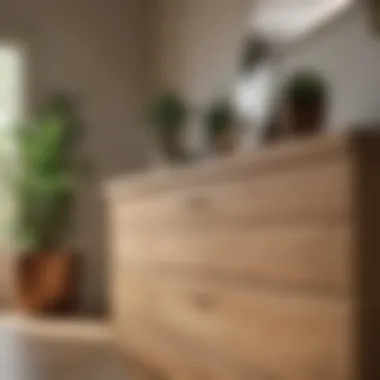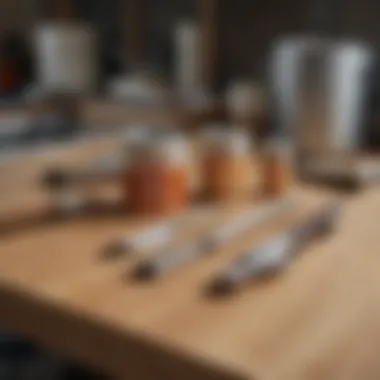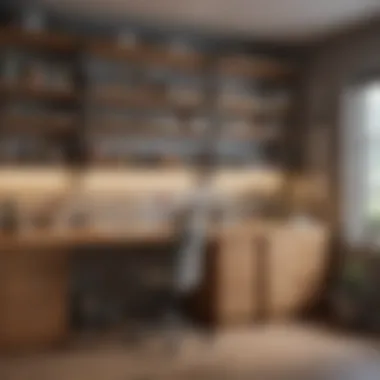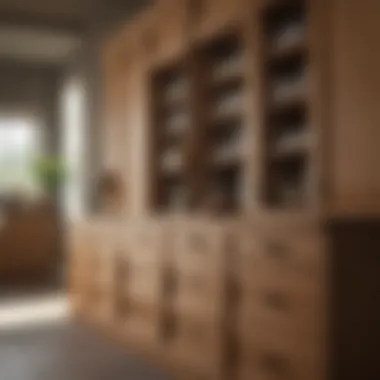Understanding the Cost of Painting Oak Cabinets


Intro
Homeowners frequently consider painting their oak cabinets when remodelling or modernizing their kitchens. It can significantly change the look of a space without a complete overhaul. However, the costs associated with this endeavor can be complex. Understanding these costs is essential for accurate budgeting. Factors such as labor, materials, preparation, and techniques all play a role in the total expense. This article aims to explore these aspects, providing a comprehensive guide for those looking to embark on this project.
Design Trends
Current Popular Styles
Current trends in cabinetry emphasize simplicity and functionality. Many homeowners are shifting towards a modern aesthetic, which favors clean lines and minimalistic designs. Among popular styles, shaker cabinets remain a go-to. Their classic elegance, combined with a straightforward structure, fits well into various kitchen designs.
In contrast, some homeowners opt for more contemporary looks with flat-panel cabinets. These provide a sleek, unadorned appearance and are often used in high-end renovations. Each style can be effectively enhanced with appropriate paint colors and finishes, contributing to the overall theme of the kitchen.
Color Palettes for Modern Spaces
Color selection is a crucial aspect when painting oak cabinets. Neutral tones such as whites, greys, and beiges have gained popularity due to their versatility. These colors can create a fresh, airy feel in the kitchen while allowing for easy integration with different decor elements.
Bold colors, like navy blue or forest green, can also make a striking statement. Pairing these with contrasting hardware can elevate the kitchen's overall design. Moreover, matte finishes are on trend, providing an understated elegance that complements modern aesthetics.
"Choosing the right color palette can transform your kitchen into a reflective personal space, enhancing both functionality and ambiance."
Intro to Cabinet Painting
Cabinet painting is a pivotal undertaking in home improvement, particularly for those looking to revitalize their space. Painting oak cabinets can significantly enhance the aesthetic and value of a kitchen or bathroom. Understanding the costs associated with this process is essential for homeowners to budget effectively and make informed choices. This section provides an overview of both the practical and financial aspects of cabinet painting.
The decision to paint cabinets often arises from a desire for change without the expense of complete replacement. Oak cabinets, known for their durability and classic appearance, offer a solid foundation for a fresh look. Painting them can yield more than just a new color; it can breathe new life into an entire room. The process, while rewarding, involves various considerations that include material quality, labor expenses, and required preparation.
Consider the longevity and maintenance of the painted surface. High-quality paint and proper techniques can lead to lasting results, reducing the frequency of touch-ups or complete repaints. Thus, while upfront costs may seem daunting, they often lead to better long-term value. By understanding both the costs and the benefits—like enhanced aesthetics and property value—homeowners can navigate their options with greater confidence and clarity.
Overview of Oak Cabinets
Oak cabinets are a popular choice in many homes, prized for their attractive grain and long-lasting nature. Made from hardwood, they provide sturdy structure and reliability. The natural warmth of oak appeals to many homeowners and interior designers alike. However, as tastes evolve, the wood's appearance may seem dated or mismatched with new design trends.
Painting oak cabinets is a practical solution that allows homeowners to preserve their investment while updating their decor. It is important to note that oak's porous surface can require special treatment when painted, making initial preparation critical. Without proper sanding, cleaning, and priming, the paint may not adhere well, leading to peeling or discoloration over time.
Why Paint Oak Cabinets?
There are several compelling reasons to consider painting oak cabinets. First, updating the color can transform the entire feel of a space, aligning it with current trends or personal tastes. Second, painting can be a cost-effective alternative to replacing cabinetry entirely, which is often a much more substantial financial commitment.
Another factor to consider is sustainability. Rather than discarding functional cabinets, painting contributes to reducing waste. This approach is environmentally friendly and aligns with the growing trend of conscious consumerism.
Moreover, the ease of maintenance is a significant advantage. A well-painted cabinet can be wiped clean easily, requiring less effort than maintaining wood finishes. In summary, painting oak cabinets not only enhances visual appeal but also offers economic and ecological benefits, making it a sensible choice for many homeowners.
Initial Cost Considerations
When homeowners embark on the journey to paint oak cabinets, understanding the initial cost considerations is vital. An effectively planned budget can not only save money but also direct the renovation process smoothly. This aspect influences the overall success of the project by ensuring that everything is aligned with both financial capabilities and the desired outcome.
Good preparation helps in anticipating expenses related to labor and materials. It also involves weighing the benefits of painting against the upfront investment. A thorough understanding of cost factors can frame realistic expectations and foster informed choices about aesthetics and utility.
Factors Influencing Pricing
Several factors play a role in determining the cost of painting oak cabinets. These can include:
- Size of the Project: The larger or more complex the cabinetry, the higher the cost.
- Quality of Materials: Higher quality paints and primers typically lead to greater durability, but they also raise expenses.
- Local Market Rates: Costs can vary significantly based on geographic location.
- Preparation Work Needed: Additional tasks such as sanding or repairing surfaces may add to labor time and materials.
- Desired Finish: Specialty finishes will impact both material costs and time needed for application.
Each of these aspects needs careful evaluation. Missing one can distort the expected financial outline, leading to possible overruns.


Understanding Labor Costs
Labor costs constitute a significant portion of the total expense when painting oak cabinets. These costs are influenced by several elements, such as:
- Experience of Painters: Skilled professionals may charge more, but their expertise often justifies the cost through superior results.
- Regional Variability: Labor prices can differ widely based on location, with urban areas typically commanding higher rates.
- Project Scope: The time required for preparation, application, and drying can considerably extend labor estimates.
- Contractor vs. DIY: Hiring a contractor means incurring labor charges, while doing it yourself can cut costs significantly but requires time and effort.
Understanding these aspects of labor costs enables homeowners to make more informed choices, balancing budget with the quality of work desired. It also emphasizes the importance of getting quotes from multiple professionals, helping ensure a reasonable price for local labor.
Material Expenses
Understanding the material expenses involved in painting oak cabinets is significant, as they directly affect your overall budget. The choice of materials can influence both the short-term costs and the long-term durability of the cabinets. A well-informed selection not only enhances the esthetic appeal of your kitchen but also ensures that the project withstands daily wear and tear.
Types of Paint Suitable for Oak Cabinets
Selecting the right paint is critical for oak cabinets. The most common types include latex paint, acrylic latex paint, and oil-based paint.
- Latex Paint: This water-based option is popular for its quick drying time and easy cleanup. It also provides a durable finish, making it suitable for kitchen applications.
- Acrylic Latex Paint: A step up from standard latex, this type offers superior adhesion and flexibility. It resists yellowing and is less likely to crack over time.
- Oil-Based Paint: While oil-based paints provide a smooth finish, they take longer to dry and emit strong fumes. However, they are some of the most durable options for cabinets and can endure higher moisture exposure.
Choosing the right type depends on your specific project needs, including desired finish and durability.
Estimating Quantity of Paint Required
Estimating the amount of paint needed is key to managing your costs effectively. One gallon of paint typically covers about 350 to 400 square feet. To calculate the quantity needed:
- Measure the total surface area of your cabinets, including doors, frames, and any other exposed areas.
- Factor in the number of coats you plan to apply. Typically, two coats are recommended for optimal coverage.
- Add a small buffer to your estimate to account for any miscalculations or touch-ups that may be necessary.
For instance, if your cabinets have 200 square feet of surface area, you would likely need two gallons of paint to ensure full coverage across two coats.
Additional Supplies Needed
In addition to paint, several supplies are necessary for a complete project:
- Primer: A high-quality primer is essential, especially for oak, to ensure proper adhesion and a smooth finish.
- Sandpaper: Different grits are recommended for the prep work. Start with 120 grit to remove the old finish and move to higher grits for smoothing.
- Brushes and Rollers: Select high-quality brushes or rollers designed for the paint type you are using.
- Drop Cloths and Tape: Protect your floors and surrounding areas with drop cloths. Use painter's tape to create clean lines around edges.
These materials are not just ancillary expenses; they are critical to achieving a professional appearance while maintaining the integrity of the cabinets over time.
Preparation Steps
Preparation is a crucial phase when painting oak cabinets. Proper preparation can significantly affect the final look and durability of the paint finish. Skipping or rushing through preparation steps may lead to complications later, such as poor adhesion and a less-than-professional appearance. Thus, investing time and effort in the preparation process is a smart move.
Removing Cabinet Doors and Hardware
Removing cabinet doors and hardware is the first step in the preparation process. This action allows for more accessible and even painting. It also prevents overspray on surfaces that do not need painting. Loosening hinges and removing knobs, pulls, and any other hardware enables you to work with a clean canvas. If needed, label each door and its corresponding hardware for easier reassembly.
- Gather the necessary tools such as a screwdriver and a small container for screws.
- Carefully remove the screws and keep them in your labeled container.
- Store hardware components in a safe space to avoid losing them.
Taking these steps helps maintain organization and can save time during the reinstallation process.
Cleaning and Sanding Surfaces
After removing all hardware and doors, cleaning and sanding the surfaces is essential. Oak wood often has a finish that can inhibit paint adhesion. Properly cleaning the surfaces ensures that grime, grease, and old finishes do not interfere with the new paint. This task enhances the durability and longevity of the new coat.
- Use a degreaser or a mixture of warm water and mild soap to clean the cabinet surfaces thoroughly.
- Follow this by sanding the surfaces lightly with fine-grit sandpaper; this creates a rough texture that improves adherence.
- Always remember to remove dust with a damp cloth after sanding.
This careful method called surface preparation can prevent flaking or peeling in the future.
Priming the Cabinets


Priming is another critical step that should not be overlooked. Priming provides a base layer that improves paint adhesion, provides a more uniform finish, and helps block any stains or tannins from the oak wood that could otherwise bleed through the paint over time.
- Select a high-quality primer designed for use on wood surfaces. This can make all the difference in achieving an even finish.
- Apply the primer using a brush or roller, ensuring full coverage.
- Allow the primer to dry completely as per the manufacturer's instructions before proceeding to the painting phase.
A well-primed surface is essential for attaining a successful painted finish that lasts.
Remember: Each of these preparation steps contributes significantly to the overall outcome of the painting project. Ignoring these can lead to additional expenses and a less satisfying result.
Painting Techniques
In the context of painting oak cabinets, the techniques employed are not merely matters of preference but have significant implications on the outcome. The choice between spray painting and brush painting can influence the overall finish, efficiency, and even the longevity of the paint job. Each method carries its own set of benefits and considerations that impact the project’s success.
Spray Painting vs. Brush Painting
Spray painting is often favored for its efficiency and ability to produce a smooth, even finish without the brush strokes that can sometimes mar a newly painted surface. This technique is particularly useful when aiming to achieve a high-gloss or satin sheen. However, it requires specific tools, such as a spray gun, and a well-ventilated area to handle the overspray. For those involved in DIY projects, this may necessitate additional preparation steps, including masking off adjacent areas to prevent paint overspray, which can add to overall time requirements.
Brush painting, on the other hand, offers more control over the application. This can be crucial when working with intricate designs or detailing on cabinets. Selecting the right brush is vital; a synthetic brush will work well with latex paints, while a natural bristle brush is beneficial for oil-based paints. This method allows for careful layering but may result in visible brush strokes if not done correctly. For a seamless appearance, proper technique and patience are necessary.
Both methods have their place in cabinet refinishing. Homeowners need to consider their skill level, the desired finish, and the amount of time they can dedicate to the project when making a choice.
Tips for Achieving a Professional Finish
Achieving a professional finish when painting oak cabinets is largely about preparation and technique. Here are several crucial tips to follow:
- Surface Prep is Key: Always ensure the cabinets are properly cleaned, sanded, and primed. This provides the foundation for a flawless finish. Neglecting these steps can lead to paint adhesion issues and an uneven surface.
- Choose Quality Materials: Using high-quality paint specifically formulated for cabinetry will result in better durability and a more attractive finish. Consider brands like Sherwin-Williams or Benjamin Moore for reliable options.
- Apply Thin Coats: When painting, whether spraying or brushing, apply thin coats of paint. This prevents drips and allows each layer to dry thoroughly before adding another. For best results, follow the manufacturer's suggested drying times between coats.
- Finish with a Top Coat: After painting, consider applying a clear top coat. This can provide additional protection against scratches and stains, which is particularly useful in high-traffic kitchen areas.
- Inspect Your Work: Take time to carefully inspect your work after the final coat. Touching up any imperfections will elevate the overall appearance.
Taking the time to master painting techniques can be the difference between a lackluster finish and a cabinet transformation that enhances the entire kitchen.
Calculating Total Project Costs
Understanding the total costs involved in painting oak cabinets is an essential step for any homeowner contemplating this undertaking. The financial commitment is not just about acquiring paint and brushes; it involves several factors—the careful consideration of which can significantly impact the overall budget. Knowing how to calculate these costs assists in avoiding unexpected expenses, allowing for a clearer view of what the entire project entails.
Creating a Detailed Budget
Creating a detailed budget is the cornerstone of effectively managing a painting project for oak cabinets. First, gather estimates for all required materials and labor.
- Materials: Include costs for paint, primer, cleaning supplies, sandpaper, and tools like brushes or sprayers.
- Labor: If hiring professionals, get multiple quotes from reliable contractors. This could vary based on experience and location.
- Timeline: Consider the length of the project. Extended projects may incur additional costs, especially if disruptions occur.
- Contingency Fund: Allocate a percentage of your budget for unforeseen problems, such as additional repairs on the cabinets before painting.
A practical approach is to itemize each cost, ensuring transparency throughout the budgeting process. This way, you can track expenses and adjust if necessary.
Important: A comprehensive budget not only delineates expected costs but also serves as a financial guide to help make informed decisions during the painting process.
Hidden Costs to Consider
Identifying hidden costs often leads to better financial planning and fewer surprises during the project. Some elements typically overlooked include:
- Surface Preparation: If the cabinets require extensive cleaning or repairs, these activities may involve additional costs, such as new materials or specialized labor.
- Finishing Touches: Depending on the desired finish, additional products like sealants or topcoats may be required, which can add to the overall expense.
- Time Investment: Understand that while DIY methods can save money, they also demand significant time, possibly impacting other home priorities.
- Disposal Fees: If existing materials or especially hazardous substances are involved, there may be disposal costs that should be factored in.
By being aware of these possible costs, homeowners can prepare better and make informed choices about their painting project. Taking the time to plan for these expenses can make the process smoother and more enjoyable.
Cost Comparison with Replacement
When considering updating your kitchen, one of the most significant decisions is whether to paint existing oak cabinets or replace them entirely. This article section will analyze the costs involved in both options, addressing the implications behind the financial choices and the value to your home.
Pros and Cons of Painting vs. Replacing Cabinets
Painting Oak Cabinets


- Cost-effective: Painting typically involves lower expenses. Labor and materials for painting are usually less than buying new cabinets.
- Convenience: This option often takes less time. Homeowners can complete projects in days instead of weeks.
- Aesthetic improvement: Fresh paint can refresh the look of cabinets, presenting an updated appearance without needing structural changes.
However, there are drawbacks to consider:
- Durability concerns: Painted finishes may chip, peel, or fade over time.
- Skill requirement: Achieving a professional-like finish takes time and experience. Poor execution can lead to a disappointing result.
Replacing Oak Cabinets
- Quality materials: New cabinets may offer modern features such as soft-close hinges and better wood quality.
- Customization options: Homeowners can choose design, function, and layout more precisely when installing new cabinets.
- Long-lasting durability: High-quality cabinets often endure wear and tear better than painted surfaces.
On the contrary, the drawbacks include:
- Higher overall costs: Complete replacement can significantly impact your budget, often in the thousands of dollars.
- Disruption: The process can lead to major disruptions in your kitchen, making daily tasks challenging.
Long-term Value of Painted Cabinets
Investing in painted cabinets can lead to substantial long-term value. While replacements may enhance material quality, properly painted cabinets can last many years and maintain an appealing aesthetic.
- Financial return: Well-maintained painted cabinets can yield a strong return on investment. Potential buyers often appreciate the update, increasing your home’s market value.
- Simplicity of maintenance: With the right care, painted cabinets can be easier to clean and maintain than older wood finishes.
If you decide to go for painting, consider some care tips. Use gentle cleaning supplies to avoid damaging the finish, and regularly check for signs of wear
"Ultimately, the decision between painting and replacing hinges on several factors, including budget, desired look, and long-term plans for the home.”
Maintaining Painted Cabinets
Maintaining painted cabinets is an essential aspect that often gets overlooked. Homeowners invest significant amounts into painting oak cabinets, and without proper care, that investment can diminish quickly over time. The longevity of your painted cabinets heavily relies on how well you maintain them. This maintenance ensures that the aesthetic appeal remains intact and that the surfaces do not deteriorate prematurely.
Care Tips for Longevity
To ensure the sustainability of your painted cabinets, here are some care tips to consider:
- Regular Dusting: Use a soft cloth to wipe away dust and debris that can accumulate on surfaces. Regular dusting prevents scratches that can occur from dirt particles.
- Gentle Cleaning: Use a mild detergent mixed with water for cleaning. Avoid harsh chemicals, as they can strip paint finishes. A soft sponge works well for a gentle clean.
- Avoid Excessive Moisture: Keep cabinets dry. Excessive moisture can lead to paint peeling or wood damage beneath. Ensure that the areas around the cabinets are well-ventilated.
- Use Coasters and Trivets: When placing items on the cabinet surface, use coasters or trivets to avoid heat damage or scratching from kitchen tools.
- Touch-up as Needed: Small chips can happen over time. Keeping some leftover paint for touch-ups can help maintain a consistent look.
When to Repaint
Even with the best care, there will come a time when repainting becomes necessary. Knowing when that time is crucial to maintaining the beauty of your cabinets.
- Visible Wear and Tear: If you notice significant fading, chipping, or peeling, it’s likely time to consider a fresh coat.
- Style Updates: Trends in home design change. If you wish to refresh your kitchen look, repainting can breathe new life into oak cabinets.
- Maintenance Becomes a Burden: If upkeep starts feeling excessive and your cabinets consistently show signs of neglect despite your efforts, it may be practical to opt for a repaint.
Remember, repainting is not just a cosmetic change; it can also protect the wood and extend the life of your cabinetry.
By following these care tips and understanding when to repaint, homeowners can maximize the durability of their painted oak cabinets, maintaining both their aesthetic charm and functionality.
Culmination
In any project involving home renovations, especially painting oak cabinets, understanding the costs associated is crucial. The aspects discussed in this article provide a solid base for homeowners to evaluate their decisions. These elements help outline the overall budget, ensure all necessary considerations are made, and avoid unexpected expenses.
Summarizing Cost Factors
The cost factors affecting the painting of oak cabinets can be categorized into several distinct areas:
- Material Costs: The price of paint, primers, and additional supplies can vary significantly. Quality products often guarantee better results, leading to longer-lasting finishes.
- Labor Costs: If hiring professionals, understanding labor charges is vital. Hourly rates or project estimates often differ based on the complexity of the job and regional pricing.
- Preparation Costs: This includes the time and effort spent on cleaning, sanding, and priming the cabinets before any paint is applied. Proper preparation is essential for achieving a flawless finish.
Those factors will considerably impact the total cost. A thorough budget will help track these variances and ensure that the renovation remains within financially reasonable boundaries.
Final Considerations for Homeowners
For homeowners contemplating this project, several final thoughts are essential:
- Investment in Quality: While it might be tempting to cut corners, investing in high-quality paint and materials ultimately provides better longevity and appearance.
- DIY vs. Professional Help: Assess your skills and available time. If lacking expertise or experience, hiring professionals may save time and ensure a superior final result.
- Understanding Needs: Consider factors like the kitchen's overall design, color preferences, and how the painted cabinets will match existing decor. A cohesive look adds more value to the home.
- Maintenance: Once the cabinets are painted, regular care will prolong their aesthetic appeal. Homeowners should be ready to commit to routine cleaning and occasional touch-ups.
The consideration of these points will guide homeowners towards making informed decisions regarding painting oak cabinets, transforming their kitchens effectively without overspending.















